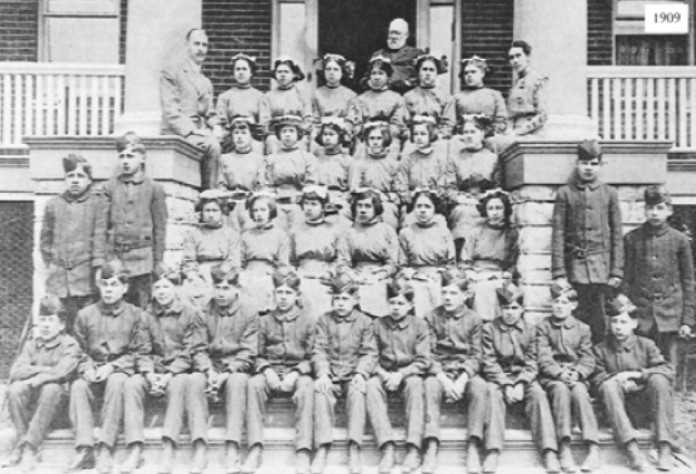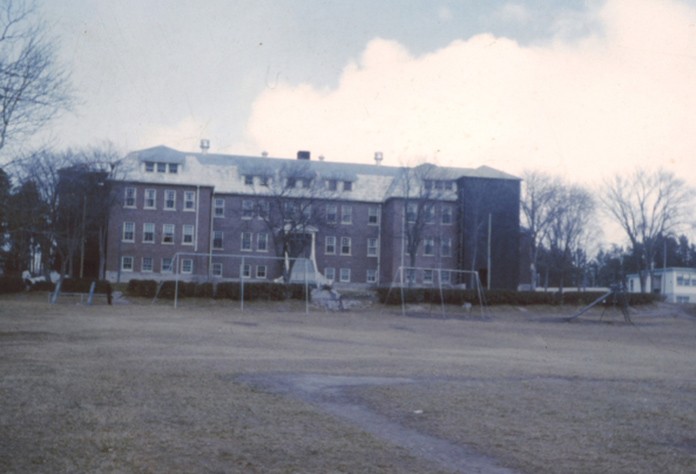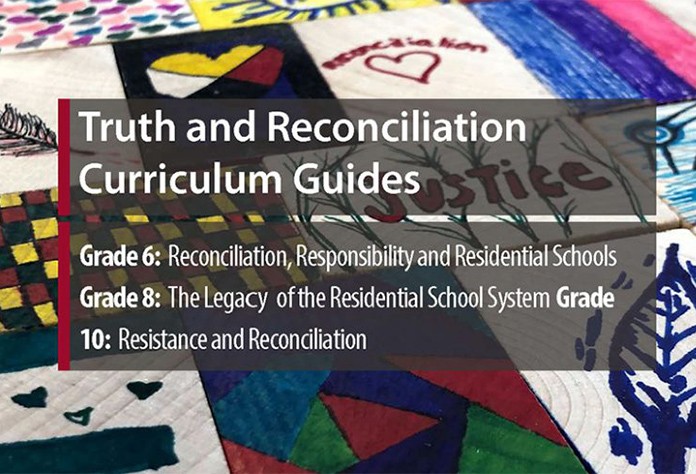Resistance & Reconciliation: St. Anne’s Residential School
In this unit looking at the Residential School System and St. Anne’s Residential School, students refine their critical and historical thinking skills. Lesson one engages students in a station-based learning strategy that seeks to deepen their understanding of each historical thinking skill, including examinations of evidence, historical significance, historical perspectives, cause and consequence, continuity and change, and the ethical dimension. As the unit progresses, students then practice these ways of thinking and analyzing. In lesson two of the unit, students engage with various government legislation and policies in order to cultivate a robust understanding of the historical significance of residential schools. In lesson four, they then create a detailed timeline of the causes and consequences of the Truth and Reconciliation Commission (TRC), examining how issues such as the Royal Commission on Aboriginal Peoples, missing and murdered Indigenous women and girls, and children in care all affect – and are affected by – the TRC. Finally, this unit engages heavily with historical perspectives and the ethical dimension, as students are guided to grapple with their own role in reconciliation efforts across the country.
St. Anne’s Residential School was run by French-speaking Catholic Church priests and nuns (the Catholic Orders of Oblates and the Grey Sisters of the Cross) from 1902 until 1976 (Barrera, March 29, 2018). The federal government began funding the school in 1906, as per Treaty #9 which covers this area. Developed and signed in 1905, Treaty #9 designated that “His Majesty agrees to pay such salaries of teachers to instruct the children of said Indians, and also to provide such school buildings and educational equipment” (The Shingwauk Project, 2009, p. 6).
The school was located in Fort Albany (now the Fort Albany First Nation), on the west side of James Bay in northeastern Ontario. It served the communities of Fort Albany, Winisk, Openagow, Attawapiskat, and Fort Hope. The Indigenous populations in these areas are primarily Mushkegowuk (Swampy Cree), with smaller populations of Ojibwe, who speak Swampy Cree and Ojibwe dialects, respectively.
St. Anne’s Residential School was isolated, as Fort Albany is on the northern mouth of the Albany River. “The post at Fort Albany had no phone and few outsiders ever visited the school. The roads in Ontario ended at the town of Cochrane. From there it was a 150-mile train ride to the port of Moosonee. From Moosonee the only way north was by barge in summer along James Bay or by dog team in winter” (Angus, 2015). Today, the community is still a fly-in community in the summer, but can be accessed by an ice road in the winter.
The mistreatment of students at St. Anne’s was some of the worst in Canada’s residential school history, and it is also some of the most well-documented (Metatawabin & Shimo, 2014). The documentation of abuses began when letters and complaints were sent to Jean Chrétien at the Department of Indian Affairs starting in 1968. The first letter came from a teacher upon resigning, outlining the mistreatment of students and staff by the Catholic administration. Later reports to the ministry in the early 1970s revealed that students were being kicked and beaten (Barrera, 2016).
Further documentation of abuses came when the community of Fort Albany held a healing conference in 1992, in order to discuss the abuses suffered in the school, and to address the intergenerational trauma that came as a result of these abuses (Platiel, August 19, 1992). This gathering, with over 300 people in attendance, heard testimonies of over 30 former students and prompted an investigation by the Ontario Provincial Police (OPP) into past wrongdoings. The investigation by the OPP lasted over five years, interviewed more than 900 people from across Canada, and documented the range of abuses suffered by children at the school. In 1997, seven sexual assault and assault charges were laid against former St. Anne’s employees (Appleby, 1997). When the Truth and Reconciliation Commission (TRC) was launched in 2008, access to the OPP investigation documents was originally denied by the federal government. However, many survivors from the community launched court cases requesting the documents be included in the TRC hearings. Led by survivor Edwin Metatawabin, this process lasted years and was fraught with continued colonial attitudes in court (Scholey, 2018), but eventually some of the documents were released (Galloway, December 14, 2017). Despite the final recommendations of the TRC having been released, the Catholic Church has still refused to apologize for its role in the abuse of the students at St. Anne’s (Galloway, March 29, 2018).
Students at St. Anne’s Residential School were on a half-day system, similar to other residential schools - attendance was mandatory. In the mornings, children attended classes, and in the afternoons, they were divided by gender to carry out manual labour at the schools. The boys often did chores relating to the livestock and the farm, and the girls would do domestic chores, such as washing and cleaning (The Shingwauk Project, 2009, p. 113). One survivor recalls that they were forced to do housework all day long (Korkmaz, 2018).
Despite the schools’ students being fluent in Swampy Cree, the children were not allowed to speak their language, in classes or to one another. “They told me not to speak my language ... so I always pretended to be asleep at my desk so they wouldn’t ask me anything” (TRC, 2015, p. 85).
In addition, students were often punished for trying to retain their language. “Peter Nakogee recalled being punished for writing in his notebook in Cree syllabics at the Fort Albany, Ontario, school” (TRC, 2015, p. 85). The food at St. Anne’s was also inadequate. “Ellen Okimaw, who attended the Fort Albany, Ontario, school, had vivid memories of poorly cooked fish served at the schools. The school cook had simply ‘dumped the whole thing, and boiled them like that, just like that without cleaning them’” (TRC, 2015, p. 91). Students who rejected the food or got sick from eating it were also punished. “Bernard Sutherland recalled students at the Fort Albany school being forced to eat food that they had vomited. ‘I saw in person how the children [ate] their vomit. When they happened to be sick. And they threw up while eating’” (TRC, 2015, p. 91).
Due to the overcrowding of the dormitories, children would often get sick, especially with lice and tuberculosis (Korkmaz, 2018). The poor living conditions and abuse at the school also prompted children to try to run away or escape back to their home communities. During one such attempt, three boys went missing from the school, whose bodies were never found, and deaths were never investigated (Angus, 2015). In addition, between the years of 1932-1945, 19 children died of unknown causes or illness (The Shingwauk Project, 2009, pp. 117-118). One student recalls two students who likely tried to run away freezing to death during their attempt, and being brought back to the school on toboggans (Barrera, September 23, 2018).
St. Anne’s Residential School is notorious for the the depth and severity of abuses suffered by the students (Metatawabin & Shimo, 2014). “Nuns, priests and lay brothers would hit students with large straps, small whips, beaver snare wire, boards, books, rulers, yardsticks, fists and open hands, survivors told investigators. Sometimes students were locked away in the dark basement for hours at a time. They also told investigators about being force-fed porridge, spoiled fish, cod liver oil and rancid horse meat that made students sick to the point of vomiting on their plates. They said they were often forced to then eat their vomit. There were numerous allegations of sexual abuse involving nuns, priests, lay brothers and other staff, ranging from fondling and forced kissing to violent attacks and nighttime molestation” (Barrera, March 29, 2018).
Some of the worst forms of abuse also included an electric chair in the school’s basement. “The electric chair … [was] used between the mid-to-late-1950s and the mid-1960s, according to OPP transcripts and reports. Some said it was metal while others said it was made of dark green wood, like a wheelchair without wheels. They all said it had straps on the armrests and wires attached to a battery” (Barrera, March 29, 2018).
Due to the abuses suffered at the hands of the school’s priests, nuns, and employees, students also began to act abusively towards one another. As Edmund Metatawabin recalls, “In the residential schools, the secrecy began at dawn: we were beaten from the time we first awoke. Speaking out against the injustice in letters home was also cause for punishment. We coped in whatever way we could, often by imitating our oppressors. At St. Anne’s, the stronger boys beat the weaker boys either with their fists or tamarack branches. Sexual abuse was rampant too, with the staff forcing themselves on the girls and boys, and the students forcing themselves on each other” (Angus, 2015).
The legacy of St. Anne’s is one of notorious abuse, but also one of community resistance. The impacts of the abuse perpetrated against the students has had long-term effects. “The legacy of St. Anne’s is still felt from Moosonee to Fort Albany First Nation to Attawapiskat and to Peawanuck … surrounded by deaths and disappearances, constant fear and violence, the survivors interviewed by the OPP spoke about attempted suicides, struggles with addictions and broken lives” (Barrera, March 29, 2018). The report of the 1992 healing conference held in the community stated that “the eff ects of the abuse caused them to lose their spirit; they were unable to love … their marriages broke down, they physically abused their own children, they had low self-esteem, they hated themselves, they thought they were dirty, they sought refuge in alcohol or drugs, they attempted suicide while some of their former classmates committed suicide” (Platiel, September 8, 1992).
In spite of all the abuse suffered, the community is also committed to healing and dealing with the effects of intergenerational trauma. The healing conference was the first step in a generations-long healing process. This process has enabled community members and former students to talk publicly about their abuse, leading to convictions of former staff of St. Anne’s. Edmund Metatawabin, former chief and president of Peetabek Keway Keywaywin (St. Anne’s Residential School Survivors Association), said the charges give recognition to the complaints of former students. “We’re finally getting some acknowledgment for those things we brought to the surface” (Moon, 1997).




